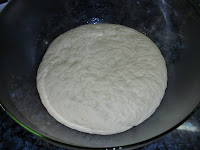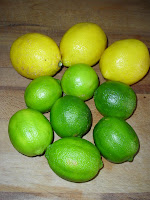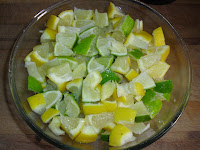This is my simple, pretty much foolproof recipe for a perfect focaccia. It's a very easy to create different flavours of focaccia so you can easily use more garlic, or no garlic, sun-dried tomatoes or thyme instead of rosemary.. the choices are endless. You can use wholemeal flour instead of plain white but the texture will be different.
For this recipe I've used the garlic, rosemary and rock salt purely as toppings and not included them in the dough. If you want, increase the amount of garlic and rosemary, chop them finely and add to the dry ingredients before adding your water to make the dough.
Recipe
225g plain white flour (no need to use strong white flour)
1/2 tsp salt
1 sachet dried yeast
150ml warm water
1 tbsp good olive oil
Topping
5 or 6 cloves of garlic, thinly sliced
several sprigs of rosemary
large grain sea salt
good extra virgin olive oil
Method
Put all of the dry ingredients into a bowl then add the tablespoon of olive oil, add the water and bring together into a rough dough. If you want to add garlic, rosemary and black olives to the dough do that before you add the water, then mix together. Make sure any additions are well chopped and not in too large pieces.
Once you have brought the ingredients together your dough should look something like this.
Using only a small amount of flour on a board or work surface knead the dough for 10 minutes or until it looks smooth and shiny.
Put the kneaded dough into a clean and lightly oiled bowl. Cover with a hot damp tea towel and leave in a warm place for 30-40 minutes. The time you need to rise the dough will depend on the temperature of the place you leave the dough. It will double in size and look slightly spongy when it's ready for a second light knead.
Once the dough has gone through the first rise, take it out of the bowl and on a lightly floured surface knead for a minute or two only. Roll out the dough to roughly 1cm thick. I like to bake my breads on an oven tray covered in parchment (baking) paper. That way I find you don't need to oil anything and the bread never sticks.
Traditionally focaccia is tear drop shaped but that's just a matter of aesthetics. Whatever shape yours ends up won't affect the taste!
I like to make my indentations (use knuckles) on the dough now, it's traditional to do it after the second rise and before you add any toppings. Cover the dough with lightly oiled clingfilm and allow it to rise a second time. At this stage I slice my garlic and wash the rosemary and pre-heat the oven to 200C, 400F or gas mark 6. By the time the oven is heated the bread will be ready for topping.
In the indentations (make them now if you didn't do them before) place the garlic slices, the sprigs of rosemary and a good sprinkling of extra virgin olive oil.
Bake in a heated oven for 25-28 minutes until golden brown. The bread is done when if you tap the underneath and it sounds hollow.
Put the bread on a cooling rack, pour some more olive oil over it and sprinkle a generous amount of sea salt over the focaccia.
Focaccia is best eaten straight away and is yummy with all kinds of dishes.
You can replace the garlic and rosemary with an equal amount of sun-dried tomatoes and thyme.
Monday, 17 October 2011
Thursday, 6 October 2011
Lemon & Lime Pickle with Ginger & Chilli
Making pickle is very easy, just time consuming in terms of chopping the fruit and waiting for the pickle to mature. It's much cheaper to make your own and once you do you'll never go back to store bought. The beauty of doing your own is you can control the spice strength and the overall flavour. This recipe is one of my favourites from many trials.
Start with roughly the same overall amount of lemons to limes. I like it slightly more lime flavoured so have added one extra lime to this batch.
Ingredients
6 or 7 limes (unwaxed or washed and scrubbed)
3 lemons (unwaxed or washed and scrubbed)
1 tblsp chopped fresh ginger
3 fresh red chillies, chopped
1 tsp dried chopped chillies
1 tsp coriander seeds
1 tsp cumin seeds
1 tsp mustard seeds
1/2 tsp nigella seeds
2 tbsp vinegar (any kind)
4 tbsp salt
1/2 tsp asafoetida (hing) for sterilising your jar
Method
Begin by gently roasting the dried chillies, coriander, cumin, mustard and nigella seeds until hot to the touch. Make sure you don't burn the mix or your final pickle will have a bitter flavour. Once the seeds become hot to the touch put the mix into a mortar and leave to cool.
While your spices are cooling, start chopping the lemons and limes retaining as much juice as possible. I like to cut the ends off the lemons and limes plus make sure there are no pips included. I know people who use the whole fruit, ends, pips and all so I leave that up to you. Put the retained juice with the vinegar into a jug and set aside. I like to cut each piece of fruit into at least 24 pieces. You'll find that once the pickle is ready to eat the pieces will be larger than when you first cut them and if you start with large pieces you'll end up with a pickle that's not as easy to eat. This is of course down to personal preference.
In the pestle and mortar, grind your now cool masala mix. It's up to you how finely you grind your mix. I like a slightly coarse texture so don't grind the mix to a fine powder. Once the mix is to the texture you want, add the turmeric and mix in.
Chop the fresh chillies and the fresh ginger and set aside with the 4 tbsp of salt. Keep these ingredients separate.
Sterilise your clean jar by putting a small amount of asafoetida (hing) into a small frying pan and heating until the powder smokes. Place your jar over the smoke and let the jar fill with the asafoetida smoke, leave for one to two minutes. This is a very traditional Indian method of sterilising.
You are now ready to start layering all your ingredients. Begin with a layer of your masala mix, then add a layer of the fruit mix, add a few pieces of ginger and a few pieces of chilli, then a layer of salt. Continue in this way until all the mixes are used up. Finally add the retained juice/vinegar mix then seal the jar and leave it alone for 3 days.
On day 4 give your mix a good stir with the handle of a wooden spoon. Stir the mix every other day for 25 to 30 days after which time all the peel should be lovely and soft and all the flavours well developed. Any juices will also have thickened. If you are lucky enough to live somewhere with sunshine you can speed up the maturing process by placing the jar in sunlight for a couple of hours a day, make sure the jar is covered with a muslin cloth or a tea towel. Be patient, the end result will be worth the wait and the finished pickle can last for a very long time. It doesn't in my house as we eat it pretty quickly.
This is my fresh batch of pickle, made today so there's no photo of the final product. In 25 days or so I'll post a photo of the end result.
Start with roughly the same overall amount of lemons to limes. I like it slightly more lime flavoured so have added one extra lime to this batch.
Ingredients
6 or 7 limes (unwaxed or washed and scrubbed)
3 lemons (unwaxed or washed and scrubbed)
1 tblsp chopped fresh ginger
3 fresh red chillies, chopped
1 tsp dried chopped chillies
1 tsp coriander seeds
1 tsp cumin seeds
1 tsp mustard seeds
1/2 tsp nigella seeds
2 tbsp vinegar (any kind)
4 tbsp salt
1/2 tsp asafoetida (hing) for sterilising your jar
Method
Begin by gently roasting the dried chillies, coriander, cumin, mustard and nigella seeds until hot to the touch. Make sure you don't burn the mix or your final pickle will have a bitter flavour. Once the seeds become hot to the touch put the mix into a mortar and leave to cool.
While your spices are cooling, start chopping the lemons and limes retaining as much juice as possible. I like to cut the ends off the lemons and limes plus make sure there are no pips included. I know people who use the whole fruit, ends, pips and all so I leave that up to you. Put the retained juice with the vinegar into a jug and set aside. I like to cut each piece of fruit into at least 24 pieces. You'll find that once the pickle is ready to eat the pieces will be larger than when you first cut them and if you start with large pieces you'll end up with a pickle that's not as easy to eat. This is of course down to personal preference.
In the pestle and mortar, grind your now cool masala mix. It's up to you how finely you grind your mix. I like a slightly coarse texture so don't grind the mix to a fine powder. Once the mix is to the texture you want, add the turmeric and mix in.
Chop the fresh chillies and the fresh ginger and set aside with the 4 tbsp of salt. Keep these ingredients separate.
Sterilise your clean jar by putting a small amount of asafoetida (hing) into a small frying pan and heating until the powder smokes. Place your jar over the smoke and let the jar fill with the asafoetida smoke, leave for one to two minutes. This is a very traditional Indian method of sterilising.
You are now ready to start layering all your ingredients. Begin with a layer of your masala mix, then add a layer of the fruit mix, add a few pieces of ginger and a few pieces of chilli, then a layer of salt. Continue in this way until all the mixes are used up. Finally add the retained juice/vinegar mix then seal the jar and leave it alone for 3 days.
On day 4 give your mix a good stir with the handle of a wooden spoon. Stir the mix every other day for 25 to 30 days after which time all the peel should be lovely and soft and all the flavours well developed. Any juices will also have thickened. If you are lucky enough to live somewhere with sunshine you can speed up the maturing process by placing the jar in sunlight for a couple of hours a day, make sure the jar is covered with a muslin cloth or a tea towel. Be patient, the end result will be worth the wait and the finished pickle can last for a very long time. It doesn't in my house as we eat it pretty quickly.
This is my fresh batch of pickle, made today so there's no photo of the final product. In 25 days or so I'll post a photo of the end result.
Wednesday, 5 October 2011
Perfect Lime Pickle
This is my recipe for lime pickle and even though it takes about a month before the pickle is ready for eating, it's worth the wait. This recipe makes a decent quantity which should last a while, unless you're like my friend Steve who eats it with everything. The last batch I made I decanted some from my large jar into smaller jars for gifts and gave away 5 jars of pickle and I still have plenty left for me. Use a glass screw top or lever top jar for storage. This pickle can last for a year or more but I guarantee you'll just keep eating it.
Ingredients
12 limes, preferably unwaxed
Ingredients
12 limes, preferably unwaxed
4 tblsp salt
10 small dried chillies, any heat you prefer
1 tsp fenugreek seeds
1 tsp nigella seeds
1/2 tsp turmeric powder
asafoetida - a pea sized amount
2 tblsp white vinegar (can use any other you like)
2 hot type fresh red chillies (optional)
zest of one unwaxed lemon (optional and not needed until pickle has 'proved')
Method
Finely chop the dried chillies and put them with the fenugreek seeds, nigella seeds and asafoetida into a heavy bottomed frying pan. Dry roast over a gentle heat until the chillies and seeds are hot to the touch. Do not over roast or they will become bitter. Set aside to cool.
You need to retain as much juice from the limes as possible and the help release juice from each lime, roll the lime firmly on a wooden board before chopping it into small pieces. I would cut each lime into at least 16 pieces. Once all your limes are cut up, put the retained juice into a jar with the vinegar.
After washing your jar in hot water, sterilise your pickle jar by placing a small amount of asafoetida in a dry pan, heat up until smoking and place the jar upside down over the asafoetida and allow the jar to fill with smoke. Leave it for 2 minutes and your jar is ready for use.
Grind your now cool chillies and seeds in a mortar and pestle to a fine powder, add the turmeric powder, this is your masala mix. If you want to use the fresh chillies, finely chop them (include seeds) but keep separate from the dry mix.
Sprinkle a layer of masala mix over the bottom of the jar, add a layer of limes, a few fresh chillies and add a good 1/2 tsp of salt, keep layering in this way until all the masala, lime, fresh chillies and salt are used up. Finish by pouring in the juice and vinegar mix.
Seal the jar and set aside for 3 days. On day 4, stir well with the handle of a wooden spoon, do not use metal. Stir the mix every other day for 25 - 30 days after which the limes should be beautifully soft and the pickle delicious.
If you have good weather you can speed up the process by placing the jar in sunlight for a few hours, cover the jar with a muslin cloth or tea towel. To add a little extra zing and summer freshness, once the pickle has proved add the zest of a lemon.
Subscribe to:
Comments (Atom)




















